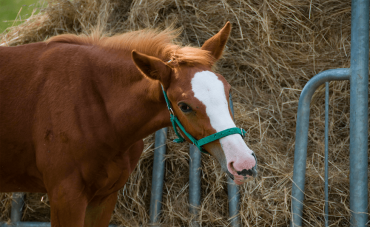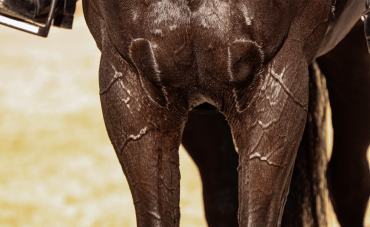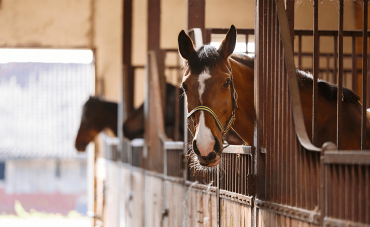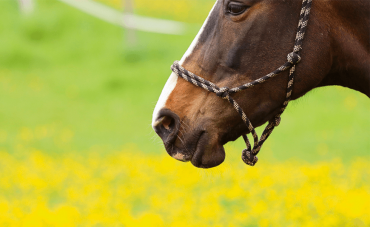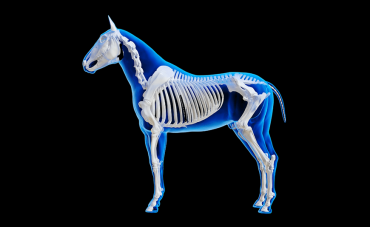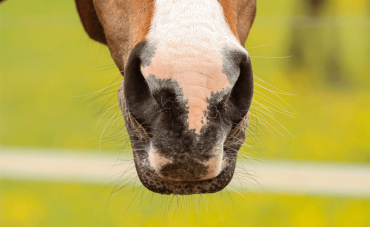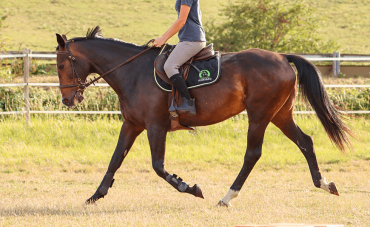In recent years, the population of older horses has steadily increased. Between 2010 and 2020, the number of horses over 15 years of age increased by nearly 40%, primarily due to improved care. Therefore, it is logical that the number of horses suffering from conditions more specific to senior horses, such as ECD, is also on the rise. Here's an overview of the condition and how to manage it.
Equine Cushing's disease, also known as Pituitary Pars Intermedia Dysfunction (PPID), is an endocrine disorder caused by a hormonal imbalance. It is linked to the premature ageing of a gland located in the horse's brain: the hypothalamus (or pituitary gland). This explains why ECD is more prevalent in older horses.
As ECD is connected to the ageing of a part of the brain, it typically develops gradually and may take several months or even years before clinical signs become apparent. This underscores the importance of veterinary care, as we will discuss later.
Predisposition for ECD
The prevalence of ECD is approximately 21% among horses over 15 years of age, and it affects up to 40% of horses over 30 years old. Although older horses are more commonly affected, younger horses can also develop the disease.
There is no known breed-specific predisposition for the development of ECD. Sometimes, ponies are thought to be more susceptible to ECD, but this is mainly because they tend to live longer, making up a larger proportion of the older horse population. Additionally, gender is not a predisposing factor for ECD, as mares, geldings, and stallions are affected in similar proportions.
Causes of ECD
Before discussing the causes of ECD, it's essential to understand which function is affected.
The hypothalamus-pituitary axis
When referring to the hypothalamus-pituitary axis in horses, we are talking about two endocrine glands: the hypothalamus and the pituitary. These glands produce hormones with various functions in the body. Among these hormones, the hypothalamus is responsible for secreting dopamine, which inhibits the production of hormones in the pituitary gland, particularly Adrenocorticotropic Hormone (ACTH). ACTH's primary role is to stimulate the adrenal glands to produce cortisol, the "stress" hormone, regulating carbohydrates, lipids, proteins, as well as immunity and circadian rhythms (such as sleep and eating patterns).
Hormonal dysfunction
In the case of ECD, the ageing hypothalamus no longer produces sufficient dopamine. Consequently, its inhibitory effect on the pituitary gland is compromised, leading to an increase in the size of the pituitary gland. The pars intermedia, a part of the pituitary gland, becomes more active, resulting in an overproduction of hormones, particularly ACTH. The overproduction of ACTH leads to the symptoms of ECD, putting the horse's entire body under stress, causing a decrease in immunity, abnormal utilisation of sugar and lipid reserves, and increased degradation of certain proteins.
Symptoms of ECD
One of the unique aspects of ECD is that symptoms vary from one horse to another and depend on the disease's stage. Some symptoms may not appear until the disease has progressed significantly. Furthermore, the initial symptoms are not specific and may include loss of condition and weight loss.
The earlier ECD is diagnosed, the more effective the care and treatment can be. Therefore, we recommend reviewing the most common symptoms. If your horse is over 15 years old and displays some of these symptoms, don't hesitate to schedule an appointment with your vet. The most common symptoms include:
- In 70% of cases: Failure to shed the winter coat completely or patchy shedding, with increased hair growth.
- In 49% of cases: Laminitis, which is a major consequence of ECD, triggered by hormonal dysfunction, mainly involving insulin.
- In 49% of cases: Amyotrophy, where the horse experiences significant muscle loss, leading to a hollow back and an overall loss of weight, making the horse appear older than it actually is.
- In 41% of cases: Lethargy or depression, causing the horse to exhibit a depressed behaviour.
- In 32% of cases: PU/PD (Polyuria Polydipsia), characterised by increased water intake and urination, often accompanied by excessive sweating.
- In 21% of cases: Neurological signs, which can manifest as movement difficulties, ataxia (balance problems), or narcolepsy.
ECD weakens the immune system which can lead to various symptoms such as skin infections (dermatophilosis, ringworm...), foot abscesses, lung infections, difficulty healing... The horse is more sensitive to any pathogen that could be found in his environment.
Diagnosing ECD
As mentioned earlier, ECD is a progressive condition, making early diagnosis challenging. However, early veterinary care is crucial to provide the best possible quality of life for older horses. The diagnosis of ECD typically involves several steps. Initially, the veterinarian may identify visible signs such as hirsutism or laminitis. To confirm the diagnosis, a blood sample may be taken to measure the ACTH levels, as horses with ECD tend to have elevated levels of ACTH in their blood.
Depending on the blood test results and the presence or absence of specific symptoms, the veterinarian will either make a definitive diagnosis or require further blood tests. ACTH levels can vary throughout the day and over the seasons, so a single blood test might not provide a conclusive diagnosis. Complementary tests, such as the dexamethasone suppression test or the TRH (thyrotropin-releasing hormone) stimulation test, are often used to compare ACTH levels before and after the injection of these substances. Based on the symptoms and test results, the veterinarian can determine an appropriate treatment plan.
Treatment for ECD
The treatment is tailored to the horse and its symptoms, highlighting the importance of regular veterinary care. Currently, the standard treatment for ECD is Pergolide. Pergolide acts as a substitute for dopamine, which the ageing hypothalamus no longer produces, and inhibits the pituitary gland to restore normal functioning, particularly by reducing the production of ACTH.
There is no definitive cure for an endocrine disorder, so Pergolide is administered daily for the horse's life. Regular veterinary monitoring is essential to adjust the dosage, measure ACTH levels in the blood, and track the evolution of the horse's various symptoms. It's worth noting that some side effects, like loss of appetite, may appear at the start of treatment, necessitating adjustments. The response to treatment varies from horse to horse, with different dosages required for each individual.
Various studies have demonstrated that Pergolide treatment results in reduced ACTH levels in 100% of treated horses. This treatment can also alleviate many symptoms, such as lethargy and PU/PD. It has a significant impact on laminitis and the immune system. However, muscle loss and weight loss are typically related to age and may persist despite treatment.
In addition to Pergolide, maintaining the horse's environment is crucial for ensuring an optimal quality of life. Horses with ECD have weakened immunity, making infection prevention essential. Establishing a clear deworming schedule helps mitigate the risk of digestive parasite infestations, while adhering to the vaccination schedule is imperative. Regular visits to monitor the feet and teeth also help prevent infections in these areas.
For horses that struggle to shed their winter coat, clipping can provide comfort during the summer. Clipping prevents the development of a "wet" area between the skin and coat, which could foster the growth of pathogens responsible for skin infections.
Since horses with ECD are highly susceptible to laminitis, consider the following tips to minimise the risks:
- Limit access to grass during spring and autumn, and monitor grazing time if necessary.
- Opt for a forage-rich diet, emphasising hay, and minimise the use of concentrated feed, especially if it is high in starch.
- Monitor the horse's weight, as excess weight can exacerbate laminitis
Additionally, feed supplements can support the treatment:
During high-risk periods, such as seasonal changes, consider boosting immunity with supplements like Immuno RS, which provide immune support and all-round protection.


